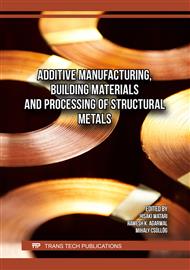p.31
p.37
p.53
p.61
p.67
p.79
p.85
p.91
p.97
The Impact of Sulphate Erosion Formation Products on the Pore Structure of Cementitious Materials during Dry and Wet Cycling- Based on Thermodynamic Simulations
Abstract:
Experimental techniques like X-ray diffraction (XRD) and pore size distribution determination (MIP), in conjunction with thermodynamic simulation (GEMS) and kinetic modeling of cement hydration (PK), were used to analyze the microstructures and phase compositions of cementitious materials under the coupling effect. This allowed researchers to study the evolution of formation products and pore structure of cementitious materials under the coupling of long-term wet and dry cycling and sulphate erosion. The findings demonstrate that the cement pastes with varying w/b ratios formed the expansion products calcium alumina and gypsum after 180 days of dry and wet cycling by 5% sodium sulphate solution; however, the specimens with lower water-ash ratios had denser structures, fewer erosion products, and better resistance to sulphate erosion. The following illustrates how sulphate erosion products affect the pore structure: during the early stages of erosion, the pore structure becomes more refined and has an increase in the number of transition pores between 10-100 nm due to the erosion products such calcium alumina and sodium sulphate crystals filling the pores. The degree of sulphate erosion is exacerbated by the formation of new cracks and larger macropores, which result in an increase in the number of erosion products, an increase in the average pore size, and a looser pore structure. However, the calcite growing in the transition pores is more destructive, and the crystallisation pressure keeps building up, leading to the destruction of some of the transition pores.
Info:
Periodical:
Pages:
97-102
Citation:
Online since:
June 2025
Authors:
Keywords:
Price:
Сopyright:
© 2025 Trans Tech Publications Ltd. All Rights Reserved
Share:
Citation:


